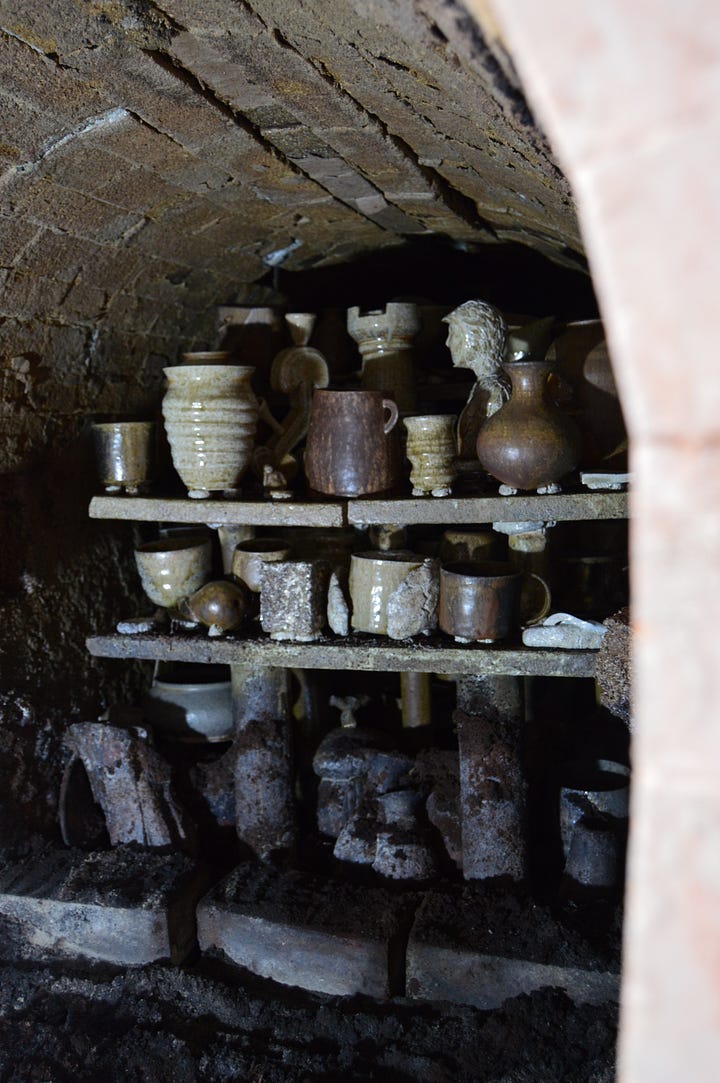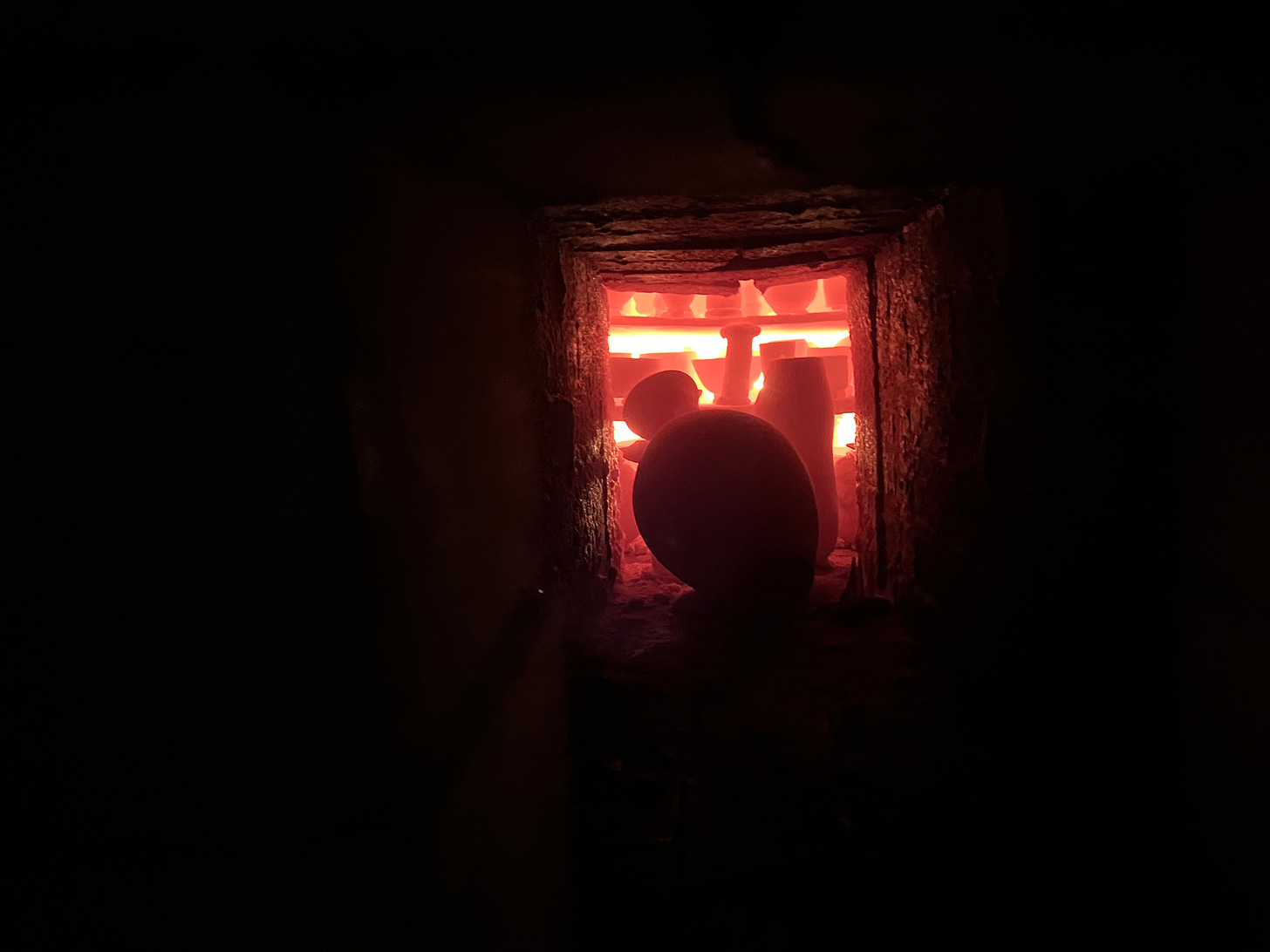Hi everyone! Happy Sunday, and a very warm welcome to our new subscribers. It’s been a busy autumn for us, and the season is still getting started – perhaps you’re feeling the same too. In these weeks of transition, I often feel a keen sense of an old cycle ending, a new one beginning – and this theme of transformation runs through this weekend’s newsletter. Exhaustion too. I’ve been working on some exciting projects recently that have taken a huge amount of energy. Among them, the great challenge and joy of working on a traditional Japanese-style wood-firing – an experience I’d like to tell you about now.
In the week leading up to the autumn equinox, I found myself in the woods near Oxford. A harvest moon hung in the sky, full and orange. I was with a group of people who were mostly strangers. What we all had in common was that we were potters; some, enviably lucky to do it for a living, others balancing our passion for pottery with the demands of working life. We had each brought 20 or so pots to be fired in an anagama kiln – meaning “cave kiln” in Japanese, this is an ancient firing structure that originated in Korea in the 5th century.
An anagama, in essence, is a long chamber built of firebricks and sealed with clay, with a chimney at the back and a firebox at the front. Over two days of painstaking preparation, pots are arranged on shelves to create the best possible pathways for the flames, and the whole thing is continuously fired for three days. During this time, the ashes from the wood will melt on the surface of the pots, creating unique textures and colours – but it is a subtle and unpredictable process, entirely dependent on the labour of the firing team, with no guarantees.
It begins gently. There are moments that feel so alive with excitement: the striking of the first flame; the young fire unfurling, licking the pine wood; gasps of awe and wide-eyed chatter extending until midnight. The novelty of fire, the pyromaniacal thrill of it. Then there are the graveyard shifts, keeping the fire alive, time warping around the smallest hours of the night. The world beyond the immediate moment becomes unimaginable, like a complete, psychoactive immersion. Eventually, the dull light of dawn tells you it’s time to sleep (“at least try to rest”), before a new cycle starts in a few hours. By then, the fire will be completely changed; no longer that sweet thing offering gentle warmth, but a roaring animal. And so it continues for three days, until temperatures reach 1,300C (2372F). By the end, the fire feels like something ineffable, as if you are looking into the heart of the sun. No wonder people believe in kiln gods. Throughout that time, there is a strange symbiosis of bodies – human, clay and flame – all feeding into one another, transforming in unison.
A cave is an opening, but it doesn’t reveal where it leads. Entering it requires a leap of faith: the belief that you will come out the other side, even if it appears to be the same side from which you entered. As we entered our particular cave, we laid down a vase of flowers and a bottle of sake: a blessing, a prayer for safe passage. Alcohol has a long-established place in sacred rituals around the world, perhaps owing to its transformative properties. The act of drinking is to cross a boundary, enter a different sensory threshold, another state of being. It’s not just about inebriation, but the sensation of taste: for a moment, those flavours on your tongue are transporting you elsewhere, peeling back the surface of everyday life. The act of drinking can also seal a transformative experience – a celebration that we have made it to the other side, and the sun is shining.
No chance of sunshine that Sunday, as our firing reached its final stages. After four thankfully dry days, it rained furiously. The sake was opened, poured between camping mugs. Music blasted from the speakers, with a distinctly ’70s and ’80s flavour. “Bennie and the Jets” is a great song on any day, but in that moment, it had never sounded so good, with rain battering the corrugated iron and a hungry fire crackling. The depth of it, the waves of pleasure it sent through my brain; it was as if I hadn’t heard music in years. And the sake, naturally cooled by the rain: a beautiful Daiginjo expression, light, fruity and unexpectedly refreshing. Soft notes of pear, lychee and melon, matched with a delicate umami note. Delicious in a way that makes you pause, catch your breath and feel grateful for these little things, tired and happy. We had reached the other side.
Three weeks have passed. Autumn is unfurling, the trees turning, and I still feel tired. But I also feel renewed with purpose, finally getting a sense of the way forward. We since went back up to Oxford to open the kiln, after a slow week of cooling, and we were astonished with the results. The gasps of joy when we peered inside; the pots were even more beautiful than we’d imagined. Now, every time I use these objects – sipping a cup of coffee, digging into a bowl of pasta – I’m transported back to the woods under the harvest moon. To those sleepless nights in front of the fire. To that moment exactly at midnight on the autumn equinox, when my firing shift came to an end and so did my twenties. The adrenaline, the sparks, the chorus of happy birthdays, the surprise of perfect little birthday cakes in the middle of the night. The immense kindness and generosity of strangers. Each of us pouring our heart into a great act of creation, figuring out a way to work as one.
These woodfired vessels hold these memories, sealed by the fire. With use, they’ll acquire new memories too, as they’re used by people I love, accompanying our shared moments. They’ll always hold this moment in time, as an old cycle reaches its end and a new one begins. Perhaps they’ll convey the exhaustion of it all, the promise of more transformation ahead. Time will tell. In the meantime, a glass of sake for my old bones.




Tending the notionary flame
Talk of flames cannot help but conjure the great Leonard Cohen. In the introduction to his posthumous poetry collection, The Flame (2018), his son Adam writes that flames were a vital image in Cohen’s work. Creation and destruction, heat and light – the importance of danger in any work of art.
“He lit the flames and he tended to them diligently. He studied and recorded their consequences. He was stimulated by their danger—he often spoke of other people's art as not having enough ‘danger,’ and he praised the ‘excitement of a thought that was in flames.’” Adam Cohen, read in full here
It strikes me as particularly useful writing advice: tending the notionary flame. The sort of professional writing I do is one thing; an act of ventriloquism, I can detach myself from it emotionally. Writing for the self, conversely, is a vulnerable process, often leaving me feeling exposed. Will people like this? What does it say about me? Does it matter? Feelings I try to work through regardless. But Cohen reminds me that where there is vulnerability, there is danger, and that is a good thing. It signals growth, the expansion of light.
“A Singer Must Die”, New Skin For The Old Ceremony (1974)
The breadth of music and poetry he leaves behind is incredible. What a joy it is to drift back through time, encounter him at different stages in his life, still discover new songs. I recently found this track buried within the 1974 album New Skin For The Old Ceremony, nestled between more famous songs such as “Chelsea Hotel #2” and “Who By Fire?”. Set up as a courtroom drama, it’s one of Cohen’s more humorous songs, a tongue-in-cheek defence of artistic freedom disguised as an apology. A defence of the artist’s right to the flame, so to speak.
What I’ve been drinking…
Apart from sake, I’ve been enjoying the simplicity of Vermouth on the rocks. While technically a wine, Vermouth is one of those drinks whose soul lies somewhere between a wine and a spirit (or liqueur). Sweet and aromatic, with an almost medicinal botanical depth, it’s often used in cocktails, but it’s delicious with just a clink of ice and a juicy twist of orange rind. The beauty of it is that, once opened, it will keep well for months – ideal for us, sporadic as we are in our tastes. Yesterday, we enjoyed a quick glass before heading out to a party – a refreshing prelude to an evening of wine. Ours is La Copa Rojo from González Byass in Jerez, made with Oloroso and Pedro Ximénez Sherries. It’s like dandelion and burdock for grown-ups.
Follow my ceramics adventure here





That was a great read! Intrigued by this anagama kiln and its results!
And Vermouth is a great drink. Just returned from Rome with many a negroni drunk.
The perfect day for Who by Fire as it is based on the Unataneh Tokef, the poem supposedly written by Yannai in the 6th Century CE, which Cohen has romanticised for an outstanding song. It declares who will be inscribed in the Book of Life for another year and is recited at Rosh HaShanah through to Yom Kippur (yesterday). Adam Cohen did a magnificent job on his father’s last album.